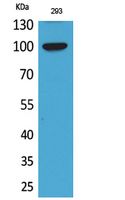Autotaxin Polyclonal Antibody
- Catalog No.:YT5359
- Applications:WB;ELISA
- Reactivity:Human;Mouse;Rat
- Target:
- Autotaxin
- Fields:
- >>Ether lipid metabolism;>>Metabolic pathways
- Gene Name:
- ENPP2
- Protein Name:
- Ectonucleotide pyrophosphatase/phosphodiesterase family member 2
- Human Gene Id:
- 5168
- Human Swiss Prot No:
- Q13822
- Mouse Gene Id:
- 18606
- Mouse Swiss Prot No:
- Q9R1E6
- Rat Gene Id:
- 84050
- Rat Swiss Prot No:
- Q64610
- Immunogen:
- The antiserum was produced against synthesized peptide derived from the Internal region of human ENPP2. AA range:401-450
- Specificity:
- Autotaxin Polyclonal Antibody detects endogenous levels of Autotaxin protein.
- Formulation:
- Liquid in PBS containing 50% glycerol, 0.5% BSA and 0.02% sodium azide.
- Source:
- Polyclonal, Rabbit,IgG
- Dilution:
- WB 1:500 - 1:2000. ELISA: 1:20000. Not yet tested in other applications.
- Purification:
- The antibody was affinity-purified from rabbit antiserum by affinity-chromatography using epitope-specific immunogen.
- Concentration:
- 1 mg/ml
- Storage Stability:
- -15°C to -25°C/1 year(Do not lower than -25°C)
- Other Name:
- ENPP2;ATX;PDNP2;Ectonucleotide pyrophosphatase/phosphodiesterase family member 2;E-NPP 2;Autotaxin;Extracellular lysophospholipase D;LysoPLD
- Observed Band(KD):
- 98kD
- Background:
- The protein encoded by this gene functions as both a phosphodiesterase, which cleaves phosphodiester bonds at the 5' end of oligonucleotides, and a phospholipase, which catalyzes production of lysophosphatidic acid (LPA) in extracellular fluids. LPA evokes growth factor-like responses including stimulation of cell proliferation and chemotaxis. This gene product stimulates the motility of tumor cells and has angiogenic properties, and its expression is upregulated in several kinds of carcinomas. The gene product is secreted and further processed to make the biologically active form. Several alternatively spliced transcript variants encoding different isoforms have been identified. [provided by RefSeq, Aug 2008],
- Function:
- catalytic activity:1-alkyl-sn-glycero-3-phosphoethanolamine + H(2)O = 1-alkyl-sn-glycerol 3-phosphate + ethanolamine.,cofactor:Binds 2 divalent metal cations per subunit.,enzyme regulation:Inhibited by lysophosphatidic acid (LPA) and sphingosine-1-phosphate (S1P). Inhibited by EDTA and EGTA. Activated by cobalt and nickel, inhibited by zinc and manganese.,function:Hydrolyzes lysophospholipids to produce lysophosphatidic acid (LPA) in extracellular fluids. Major substrate is lysophosphatidylcholine. Also can act on sphingosylphosphphorylcholine producing sphingosine-1-phosphate, a modulator of cell motility. Can hydrolyze, in vitro, bis-pNPP, to some extent pNP-TMP, and barely ATP. Involved in several motility-related processes such as angiogenesis and neurite outgrowth. Acts as an angiogenic factor by stimulating migration of smooth muscle cells and microtubule formation. Stimulates migr
- Subcellular Location:
- Secreted .
- Expression:
- Detected in blood plasma (at protein level) (PubMed:12176993, PubMed:26371182). Predominantly expressed in brain, placenta, ovary, and small intestine. Expressed in a number of carcinomas such as hepatocellular and prostate carcinoma, neuroblastoma and non-small-cell lung cancer. Expressed in body fluids such as plasma, cerebral spinal fluid (CSF), saliva, follicular and amniotic fluids. Not detected in leukocytes. Isoform 1 is more highly expressed in peripheral tissues than in the central nervous system (CNS). Adipocytes only express isoform 1. Isoform 3 is more highly expressed in the brain than in peripheral tissues.
Tafazzin mediates tamoxifen resistance by regulating cellular phospholipid composition in ER-positive breast cancer CANCER GENE THERAPY Li Xuan WB Human 1:2000 MCF7 cell
- June 19-2018
- WESTERN IMMUNOBLOTTING PROTOCOL
- June 19-2018
- IMMUNOHISTOCHEMISTRY-PARAFFIN PROTOCOL
- June 19-2018
- IMMUNOFLUORESCENCE PROTOCOL
- September 08-2020
- FLOW-CYTOMEYRT-PROTOCOL
- May 20-2022
- Cell-Based ELISA│解您多样本WB检测之困扰
- July 13-2018
- CELL-BASED-ELISA-PROTOCOL-FOR-ACETYL-PROTEIN
- July 13-2018
- CELL-BASED-ELISA-PROTOCOL-FOR-PHOSPHO-PROTEIN
- July 13-2018
- Antibody-FAQs
- Products Images

- Western Blot analysis of 293 cells using Autotaxin Polyclonal Antibody. Secondary antibody(catalog#:RS0002) was diluted at 1:20000

- Western blot analysis of lysate from 293 cells, using ENPP2 Antibody.



